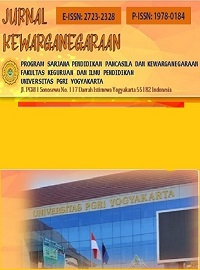Tinjauan Hukum Perdata Terkait Dengan Kedudukan Hukum dan Hak Waris Anak Luar Kawin
DOI:
https://doi.org/10.31316/jk.v8i1.6404Abstract
Abstrak
Menurut Kitab Undang-Undang Hukum Perdata (KUHPerdata), hukum perdata Indonesia menciptakan sistem warisan individu bilateral yang memberikan ahli waris bagian yang sama dari harta peninggalan kedua orang tua. Dalam pengaturan ini, pasangan yang masih hidup dan kerabat sedarah baik yang sah maupun yang tidak sah dimasukkan sebagai ahli waris. Negara akan mewarisi harta warisan jika tidak ada ahli waris. Sebelum keluarnya Putusan Mahkamah Konstitusi Nomor 46/PUU-VIII/2010, UU Perkawinan tidak mengakui hak waris anak yang lahir di luar perkawinan. Dalam hal hubungan tersebut dapat dibuktikan baik secara hukum maupun secara ilmiah, putusan tersebut mengubah Pasal 43 ayat 1 UU Perkawinan untuk memberikan hak keperdataan kepada anak dari orang tua di luar perkawinan terhadap ayahnya. Dalam Pasal 862 hingga 873 KUH Perdata, hak waris anak dari hubungan sebelumnya diatur secara rinci. Persetujuan ibu dan akta otentik diperlukan untuk pengakuan, yang memberikan perlindungan hukum dan hak waris yang adil bagi anak-anak.
Kata Kunci: Anak, Waris, Perdata
Abstract
According to the Kitab Undang-Undang Hukum Perdata (Civil Code), Indonesian civil law creates a bilateral individual inheritance system that grants heirs an equal share of both parents' estates. Under this arrangement, surviving spouses and blood relatives both legal and illegitimate are included as heirs. The state will inherit the estate if there are no heirs. Prior to the issuance of Constitutional Court Decision Number 46/PUU-VIII/2010, the Marriage Law did not recognize the inheritance rights of children born outside of marriage. In the event that the relationship can be proven both legally and scientifically, the decision amends Article 43 paragraph 1 of the Marriage Law to grant civil rights to children of parents outside of marriage against their father. In Articles 862 to 873 of the Civil Code, the inheritance rights of children from previous relationships are regulated in detail. The mother's consent and an authentic deed are required for recognition, which provides legal protection and fair inheritance rights for children.
Keywords: Children, Heirs, Inheritors
References
DAFTAR PUSTAKA
Al-Azizi, A. S. (2015). Buku Lengkap Fiqh Wanita: Manual Ibadah Dan Muamalah Harian Muslimah Shalihah. DIVA press. Hal 39.
Badriyah Harun, S. H. (2009). Panduan Praktis Pembagian Waris. Pustaka Yustisia. Hal 56.
Covic, A. V., & Stjepanovic, B. M. (2022). Inheritance in Sharia Law with an Overview of the Position of Illegitimate Children. Strani Pravni Zivot, 261.
Hartanto, J. A., & SH, M. (2018). Hak Waris Anak Luar Kawin Pasca Putusan Mahkamah Konstitusi. Jakad Media Publishing. Hal 30.
Keller, J. C. (1982). Inheritance rights of illegitimate children in Kentucky: a need for reform. Ky. LJ, 71, 665.
Kuncoro, N. W. (2015). Waris: Permasalahan Dan Solusinya. Raih Asa Sukses.
Mixon, E. (1999). Deadbeat dads: Undeserving of the Right to inherit from their illegitimate children and undeserving of equal protection. Ga. L. Rev., 34, 1773.
Molana, M. H. (2024). Kedudukan Hak Waris Anak Luar Nikah Sesudah Putusan Mahkamah Konstitusi Nomor 46/PUU-VIII/2010. Pancasakti Law Journal (PLJ), 2(1), 25-34.
Muhammad, B., Luth, T., Rachmad, A., & Hamidi, J. (2014). The Inheritance Rights Of Illegitimate Children outside Marriage in the Perspective of Children’s Rights. International Journal of Sciences: Basic and Applied Research (IJSBAR), 14(1), 49-62.
Mzee, M. M. (2016). Islamic Law of Inheritance: The Case of Illegitimate Child and Possibility of Having an Assets of Deceased Father: A Tanzanian Case Study. JL Pol'y & Globalization, 45, 55.
Onuoha, V. E., & Attah, M. (2014). The right to inherit: illegitimacy and Constitutional Liberation in Nigeria–just a legal shield?. Journal of Social Welfare and Family Law, 36(3), 226-240.
Panggabean, K. (2023). Tinjauan Teologis Hak Waris Perempuan Batak Menurut Bilangan 27: 1-11. The New Perspective in Theology and Religious Studies, 4(2), 135-160.
Poespasari, E. D., & SH, M. (2018). Pemahaman Seputar Hukum Waris Adat di Indonesia. Kencana.
Robbins, H. H., & Deak, F. (1930). The Familial Property Rights of Illegitimate Children: A Comparative Study. Colum. L. Rev., 30, 308.
Sembiring, S. (2013). Aspek-aspek yuridis dalam penerbitan buku. Nuansa Aulia. Hal 29.
Suparman, M. (2022). Hukum Waris Perdata. Sinar Grafika. Hal 42.
Yunus, A. (2020). Hukum Perkawinan dan Itsbat Nikah: Antara Perlindungan dan Kepastian Hukum. Humanities Genius. Hal 62.
Downloads
Published
Issue
Section
License
Copyright (c) 2024 Rachel Christie, Maria Jessica Lauretta Gunawan

This work is licensed under a Creative Commons Attribution-ShareAlike 4.0 International License.
Authors who publish with this journal agree to the following terms:
-
The journal allow the authors to hold the copyright without restrictions and allow the authors to retain publishing rights without restrictions.
-
Authors retain copyright and grant the journal right of first publication with the work simultaneously licensed under a Creative Commons Attribution-ShareAlike 4.0 International License that allows others to share the work with an acknowledgement of the work's authorship and initial publication in this journal.
- Authors are able to enter into separate, additional contractual arrangements for the non-exclusive distribution of the journal's published version of the work (e.g., post it to an institutional repository or publish it in a book), with an acknowledgement of its initial publication in this journal.
- Authors are permitted and encouraged to post their work online (e.g., in institutional repositories or on their website) prior to and during the submission process, as it can lead to productive exchanges, as well as earlier and greater citation of published work (See The Effect of Open Access).
This work is licensed under a Lisensi Creative Commons Atribusi-BerbagiSerupa 4.0 Internasional.













